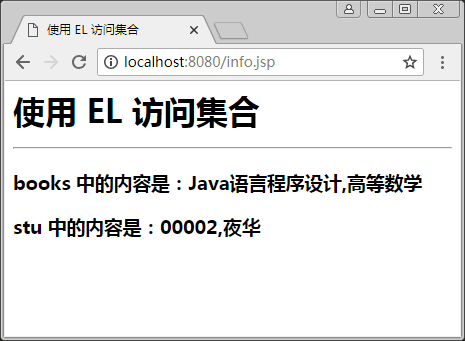返回
2022年07月13日
-
使用EL表达式访问集合
在 EL 表达式中,同样可以获取集合的数据,这些集合可能是 Vector、List、Map、数组等。可以在 JSP 中获取这些对象,继而显示其中的内容,其语法格式如下:
${collection [序号]}
其中,collection 代表集合对象的名称。例如:
${books [0]}表示集合 books 中下标为 0 的元素。
上面表示的是一维集合,如数组、List 等,若操作的集合为二维集合,如 HashMap,其值是 key 和 value 值对的形式,则值 (value) 可以这样显示:
${collection.key}
例如:
${p1.ID}表示显示名为 pi 的 HashMap 中的 key 为 ID 的元素的值。下面是通过 EL 表达式访问集合的一个案例。
【例1】通过 EL 表达式访问集合(collection_demo.jsp):
<%@ page language="java" contentType="text/html;charset=utf-8" %> <%@ page import="java.util.*" %> <html> <head> <title>使用 EL 访问集合</title> </head> <body> <h1>使用 EL 访问集合</ h1> <hr/> <% List books=new ArrayList(); books.add("Java语言程序设计"); books.add("高等数学"); session.setAttribute("books",books); HashMap stu=new HashMap(); stu.put("stuno","00002"); stu.put("stuname","夜华"); session.setAttribute("stu",stu); %> <h3>books 中的内容是:${books[0]},${books[1]}</h3> <h3>stu 中的内容是:${stu.stuno},${stu.stuname}</h3> </body> </html>程序运行结果如图 1 所示。
